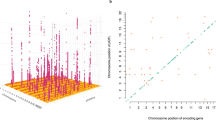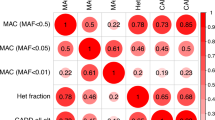Abstract
Proteome analysis is a fundamental step in systematic functional genomics. Here we have resolved 8,767 proteins from the mouse brain proteome by large-gel two-dimensional electrophoresis. We detected 1,324 polymorphic proteins from the European collaborative interspecific backcross. Of these, we mapped 665 proteins genetically and identified 466 proteins by mass spectrometry. Qualitatively polymorphic proteins, to 96%, reflect changes in conformation and/or mass. Quantitatively polymorphic proteins show a high frequency (73%) of allele-specific transmission in codominant heterozygotes. Variations in protein isoforms and protein quantity often mapped to chromosomal positions different from that of the structural gene, indicating that single proteins may act as polygenic traits. Genetic analysis of proteomes may detect the types of polymorphism that are most relevant in disease-association studies.
This is a preview of subscription content, access via your institution
Access options
Subscribe to this journal
Receive 12 print issues and online access
$209.00 per year
only $17.42 per issue
Buy this article
- Purchase on Springer Link
- Instant access to full article PDF
Prices may be subject to local taxes which are calculated during checkout



Similar content being viewed by others
References
Klose, J. Protein mapping by combined isoelectric focusing and electrophoresis of mouse tissues. A novel approach to testing for induced point mutations in mammals. Humangenetik 26, 231–243 (1975).
O'Farrell, P.H. High resolution two-dimensional electrophoresis of proteins. J. Biol. Chem. 250, 4007–4021 (1975).
Klose, J. & Kobalz, U. Two-dimensional electrophoresis of proteins: an updated protocol and implications for a functional analysis of the genome. Electrophoresis 16, 1034–1059 (1995).
Klose, J. Large-gel 2-D electrophoresis. Methods Mol. Biol. 112, 147–172 (1999).
Anderson, N.G., Metheson, A. & Anderson, N.L. Back to the future: the human protein index (HPI) and the agenda for post-proteomic biology. Proteomics 1, 3–12 (2001).
Ferris, S.D., Sage, R.D., Prager, E.M., Ritte, U. & Wilson, A.C. Mitochondrial DNA evolution in mice. Genetics 107, 681–721 (1983).
Avner, P., Amar, L., Dandolo, L. & Guenet, J. L. Genetic analysis of the mouse using interspecific crosses. Trends. Genet. 4, 18–23 (1988).
Breen, M. et al. Towards high resolution maps of the mouse and human genomes—a facility for ordering markers to 0.1 cM resolution. Hum. Mol. Genet. 3, 621–627 (1994).
Rhodes, M. et al. A high-resolution microsatellite map of the mouse genome. Genome Res. 8, 531–542 (1998).
Klose, J. Fractionated extraction of total tissue proteins from mouse and human for 2-D electrophoresis. Methods Mol. Biol. 112, 67–85 (1999).
Gauss, C., Kalkum, M., Löwe, M., Lehrach, H. & Klose, J. Analysis of the mouse proteome. (I) Brain proteins: separation by two-dimensional electrophoresis and identification by mass spectrometry and genetic variation. Electrophoresis 20, 575–600 (1999).
Klose, J. Genotypes and phenotypes. Electrophoresis 20, 643–652 (1999).
Damerval, C., Maurice, A., Josse, J. M. & de Vienne, D. Quantitative trait loci underlying gene product variation: a novel perspective for analyzing regulation of genome expression. Genetics 137, 289–301 (1994).
Lehmann, W.D. in Massenspektrometrie in der Biochemie 410 (Spektrum, Heidelberg, 1996).
Strupat, K., Laras, M., Hillenkamp, F., Eckerskorn, C. & Lottspeich, F. Matrix-assisted laser-desorption ionization mass spectrometry of proteins electroblotted after polyacrylamide gel electrophoresis. Anal. Chem. 66, 464–470 (1994).
Thiellement, H. et al. Proteomics for genetic and physiological studies in plants. Electrophoresis 20, 2013–2026 (1999).
Janke, C., Holzer, M., Klose, J. & Arendt, T. Distribution of isoforms of the microtubule-associated protein tau in grey and white matter areas of human brain: a two-dimensional gelelectrophoretic analysis. FEBS Lett. 379, 222–226 (1996).
Whitney, J.B., Cobb, R.R., Popp, R.A. & O'Rourke, T.W. Detection of neutral amino acid substitutions in proteins. Proc. Natl Acad. Sci. USA 82, 7646–7650 (1985).
Scriver, C.R. & Waters, P.J. Monogenic traits are not simple: lessons from phenylketonuria. Trends. Genet. 15, 267–272 (1999).
Cargill, M. et al. Characterization of single-nucleotide polymorphisms in coding regions of human genes. Nature Genet. 22, 231–238 (1999).
Halushka, M.K. et al. Patterns of single-nucleotide polymorphisms in candidate genes for blood-pressure homeostasis. Nature Genet. 22, 239–247 (1999).
Sunyaev, S., Ramensky, V. & Bork, P. Towards a structural basis of human non-synonymous single nucleotide polymorphisms. Trends Genet. 16, 198–200 (2000).
Lindblad-Toh, K. et al. Large-scale discovery and genotyping of single- divergence of B2m alleles of wild Mus musculus and Mus spretus implies positive selection. Immunogenetics 38, 106–116 (1993).
Lacombe, C. et al. in Protides of the Biological Fluids; Proceedings of the Colloqium Vol. 32 (ed. Peeters, H.) 1001–1003 (Pergamon, Oxford, 1985).
Noel, D., Nikaido, K. & Ames, G.F. A single amino acid substitution in a histidine-transport protein drastically alters its mobility in sodium dodecyl sulfate-polyacrylamide gel electrophoresis. Biochemistry 18, 4159–4165 (1979).
Litersky, J.M., Scott, C.W. & Johnson, G.V. Phosphorylation, calpain proteolysis and tubulin binding of recombinant human tau isoforms. Brain Res. 604, 32–40 (1993).
Gerstner, A., Csapo, Z., Sasvari-Szekely, M. & Guttman, A. Ultrathin-layer sodium dodecyl sulfate gel electrophoresis of proteins: effects of gel composition and temperature on the separation of sodium dodecyl sulfate-protein complexes. Electrophoresis 21, 834–840 (2000).
Wiltfang, J. et al. Improved electrophoretic separation and immunoblotting of β-amyloid (A-β) peptides 1–40, 1–42, and 1–43. Electrophoresis 18, 527–532 (1997).
Lai, K., Langley, S.D., Dembure, P.P., Hjelm, L.N. & Elsas, L.J. Duarte allele impairs biostability of galactose-1-phosphate uridyltransferase in human lymphoblasts. Hum. Mutat. 11, 28–38 (1998).
Burge, C. & Karlin, S. Prediction of complete gene structures in human genomic DNA. J. Mol. Biol. 268, 78–94 (1997).
Pesole, G. et al. UTRdb and UTRsite: specialized databases of sequences and functional elements of 5′ and 3′ untranslated regions of eukaryotic mRNAs. Nucleic. Acids Res. 28, 193–196 (2000).
Phillips, P.C. From complex traits to complex alleles. Trends. Genet. 15, 6–8 (1999).
Le Stunff, C., Fallin, D., Schork, N.J. & Bougneres, P. The insulin gene VNTR is associated with fasting insulin levels and development of juvenile obesity. Nature Genet. 26, 444–446 (2000).
Weiss, K.M. & Terwilliger, J.D. How many diseases does it take to map a gene with SNPs? Nature Genet. 26, 151–157 (2000).
Silva, A.J. & White, R. Inheritance of allelic blueprints for methylation patterns. Cell 54, 145–152 (1988).
Gooley, A.A. & Packer, N.H. in Proteome Research: New Frontiers in Functional Genomics (eds Wilkens, M.R., Williams, K.L., Appel, R.D. & Hochstrasser, D.F.) 65–91 (Springer, Berlin, 2001).
Kato, G.J. Human genetic disease of proteolysis. Hum. Mutat. 13, 87–98 (1999).
Neuhoff, V., Arold, N., Taube, D. & Ehrhardt, W. Improved staining of proteins in polyacrylamide gels including isoelectric focusing gels with clear background at nanogram sensitivity using Coomassie Brilliant Blue G-250 and R-250. Electrophoresis 9, 255–262 (1988).
Marcus, K., Immler, D., Sternberger, J. & Meyer, H.E. Identification of platelet proteins separated by two-dimensional gel electrophoresis and analyzed by matrix assisted laser desorption/ionization-time of flight-mass spectrometry and detection of tyrosine-phosphorylated proteins. Electrophoresis 21, 2622–2636 (2000).
Zhang, W. & Chait, B.T. ProFound: an expert system for protein identification using mass spectrometric peptide mapping information. Anal. Chem. 72, 2482–2489 (2000).
Schalkwyk, L.C. et al. Advanced integrated mouse YAC map including BAC framework. Genome Res. 11, 2142–2150 (2001).
Dietrich, W.F. et al. A comprehensive genetic map of the mouse genome. Nature 380, 149–152 (1996).
Schalkwyk, L.C. et al. Panel of microsattelite markers for whole-genome scans and radiation hybrid mapping and a mouse family tree. Genome Res. 9, 878–888 (1999).
Feinberg, A.P. & Vogelstein, B. A technique for radiolabeling DNA restriction endonuclease fragments to high specific activity. Anal. Biochem. 132, 6–13 (1983).
Church, G.M. & Gilbert, W. The genomic sequencing technique. Prog. Clin. Biol. Res. 177, 17–21 (1985).
Lander, E.S. et al. MAPMAKER: an interactive computer package for constructing primary genetic linkage maps of experimental and natural populations. Genomics 1, 174–181 (1987).
Dietrich, W. et al. A genetic map of the mouse suitable for typing intraspecific crosses. Genetics 131, 423–447 (1992).
Author information
Authors and Affiliations
Corresponding authors
Ethics declarations
Competing interests
The authors declare no competing financial interests.
Supplementary information
Rights and permissions
About this article
Cite this article
Klose, J., Nock, C., Herrmann, M. et al. Genetic analysis of the mouse brain proteome. Nat Genet 30, 385–393 (2002). https://doi.org/10.1038/ng861
Received:
Accepted:
Published:
Issue Date:
DOI: https://doi.org/10.1038/ng861
This article is cited by
-
Protein divergence in Helicoverpa armigera hemolymph induced by the dietary triflumuron alone and in binary combination with β-sitosterol
International Journal of Tropical Insect Science (2024)
-
Proteomic analysis of muscle between hybrid abalone and parental lines Haliotis gigantea Reeve and Haliotis discus hannai Ino
Heredity (2015)
-
Quantitative measurement of allele‐specific protein expression in a diploid yeast hybrid by LC‐MS
Molecular Systems Biology (2012)
-
Evolution of major milk proteins in Mus musculus and Mus spretus mouse species: a genoproteomic analysis
BMC Genomics (2011)



